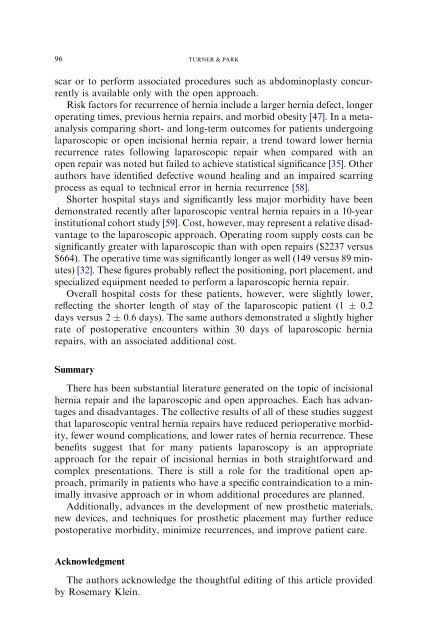Laparoscopic Repair of Ventral Incisional Hernias: Pros ... - SASSiT
Laparoscopic Repair of Ventral Incisional Hernias: Pros ... - SASSiT
Laparoscopic Repair of Ventral Incisional Hernias: Pros ... - SASSiT
You also want an ePaper? Increase the reach of your titles
YUMPU automatically turns print PDFs into web optimized ePapers that Google loves.
96 TURNER & PARK<br />
scar or to perform associated procedures such as abdominoplasty concurrently<br />
is available only with the open approach.<br />
Risk factors for recurrence <strong>of</strong> hernia include a larger hernia defect, longer<br />
operating times, previous hernia repairs, and morbid obesity [47]. In a metaanalysis<br />
comparing short- and long-term outcomes for patients undergoing<br />
laparoscopic or open incisional hernia repair, a trend toward lower hernia<br />
recurrence rates following laparoscopic repair when compared with an<br />
open repair was noted but failed to achieve statistical significance [35]. Other<br />
authors have identified defective wound healing and an impaired scarring<br />
process as equal to technical error in hernia recurrence [58].<br />
Shorter hospital stays and significantly less major morbidity have been<br />
demonstrated recently after laparoscopic ventral hernia repairs in a 10-year<br />
institutional cohort study [59]. Cost, however, may represent a relative disadvantage<br />
to the laparoscopic approach. Operating room supply costs can be<br />
significantly greater with laparoscopic than with open repairs ($2237 versus<br />
$664). The operative time was significantly longer as well (149 versus 89 minutes)<br />
[32]. These figures probably reflect the positioning, port placement, and<br />
specialized equipment needed to perform a laparoscopic hernia repair.<br />
Overall hospital costs for these patients, however, were slightly lower,<br />
reflecting the shorter length <strong>of</strong> stay <strong>of</strong> the laparoscopic patient (1 0.2<br />
days versus 2 0.6 days). The same authors demonstrated a slightly higher<br />
rate <strong>of</strong> postoperative encounters within 30 days <strong>of</strong> laparoscopic hernia<br />
repairs, with an associated additional cost.<br />
Summary<br />
There has been substantial literature generated on the topic <strong>of</strong> incisional<br />
hernia repair and the laparoscopic and open approaches. Each has advantages<br />
and disadvantages. The collective results <strong>of</strong> all <strong>of</strong> these studies suggest<br />
that laparoscopic ventral hernia repairs have reduced perioperative morbidity,<br />
fewer wound complications, and lower rates <strong>of</strong> hernia recurrence. These<br />
benefits suggest that for many patients laparoscopy is an appropriate<br />
approach for the repair <strong>of</strong> incisional hernias in both straightforward and<br />
complex presentations. There is still a role for the traditional open approach,<br />
primarily in patients who have a specific contraindication to a minimally<br />
invasive approach or in whom additional procedures are planned.<br />
Additionally, advances in the development <strong>of</strong> new prosthetic materials,<br />
new devices, and techniques for prosthetic placement may further reduce<br />
postoperative morbidity, minimize recurrences, and improve patient care.<br />
Acknowledgment<br />
The authors acknowledge the thoughtful editing <strong>of</strong> this article provided<br />
by Rosemary Klein.
















